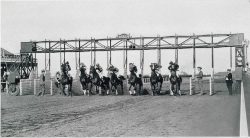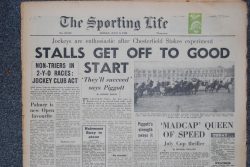In our latest blog first published in February 2019 Tim Cox, a former Trustee of the National Horse Racing Museum and owner of the Cox Library looks at the history of starting races.
In the Main Galleries the simple hand-held red flag that was once owned by Henry Custance is on display. Custance is the only jockey to have won the Derby (1860, 1866 and 1874), and then to have started the race (1885). This flag represents Phase 1 in bringing discipline to the start of races so that every horse has an equal chance of winning.
Before the introduction of starting stalls in 1965, the start of a horserace could be chaotic. For almost 150 years the racing authorities had tried various methods to bring the start under control. The challenge was to find a system that could cope with an increase in the number of horses in each race and an increase in the number of shorter distance races in which the importance of a good start becomes more important. They introduced new Rules; they gave greater authority to the starter; they increased the penalties for ignoring the Rules and they tried new technologies.
Phase 1: The Flag Start 1825 – 1897
The traditional way of starting a race was for the starter to wave his hand and shout ‘Go’. Before 1817 there had only been three reported false starts*. And then there were three in the St Leger of 1817 alone. Through the 1820s it became clear that the number of false starts was getting out of hand, particularly in major races. Something had to be done.
Joseph Lockwood, the starter at Doncaster, took the initiative and introduced a recall flag in 1825. A red flag would be hoisted at the start if there was a false start. Another flag about 300 yards down the course would be raised at the same time. A raised flag would tell the jockeys to return to the start. Although this did not prevent a false start, it did reduce the time and energy wasted in galloping too far. Later the system was modified. The flag would be dropped to indicate a start and the recall man would drop his flag at the same time.
Change came slowly. Epsom for the Derby and Ascot introduced the flag system in 1829. But there were still fourteen false starts in the 1830 Derby. In 1832 the leading sporting newspaper, Bell’s Life in London, complained that there were nearly always eight or ten false starts in races over shorter distances at Newmarket, “the effect being to disgust the spectators and destroy the tempers of the horses”. They described the starter at Newmarket as ‘personally incompetent…without any control or authority over the jockeys, who may play any tricks they please with impunity, as there is no penalty for disobeying him”.
The Jockey Club did introduce a new Rule in 1832. This gave authority to the starter ‘to order the jockeys to draw up in a line as far behind the starting-post as he may think necessary’ and to fine ‘any jockey disobeying the orders of the starter, or taking any unfair advantage’ up to £5. In 1856 the fine for a second offence was increased to £10 and for a third £25. If that did not deter the jockey, the Stewards could suspend him from riding for as long as they thought fit.
False starts continued to be a problem. A notorious occasion happened at the Croydon meeting on 2nd June 1871. The last race was scheduled for 5 o’clock, but the horses did not get to the start until 7 o’clock after false starts in earlier races. The last race was eventually abandoned after more false starts. The two main culprits were suspended from riding until the 1st May 1872.
Lockwood has not been credited with introducing a flag system perhaps because he was subsequently suspected of accepting a bribe to leave Mameluke at the start. Later historians wrongly credit Lord George Bentinck, the great Turf reformer, with introducing the flag system.
What Lord George did bring to the start was personality and authority. He put himself at the centre of the jockey’s attention and did not hesitate to fine anyone breaking the line. For the 1844 Chester Cup the Stewards asked him to take over from the designated starter. His task was to start twenty-six horses on a narrow track. He devised a scheme of dividing the field into two ranks with the riders drawing lots as to whether they were in the first or second rank. Any unruly horse would be relegated to the third rank. The horses took their positions nearly a quarter of a mile from the starting post and with Lord George walking along side they got off to a clean start.
Not all official starters had the stature of Lord George. Even Admiral Rous, the leading authority on the Turf, had a go at starting the 1861 Royal Hunt Cup. He thought his appearance alone would ‘strike terror and dismay into the hearts of the unruly jockeys’. In fact, he had absolutely no control over them. After an hour’s delay and when the animals were in a worse position than they had been at any time before, the irate Admiral threw down the flag, shouting at the same time “Go, and be d….d to you’.
From 1877 horses were lined up in the order determined by lots drawn by the jockeys at the time of weighing out. This added to the burden of starting races for the starter.
Phase 2: The barrier system 1897 – 1965

The flag system had to be replaced, but it was not until October 1897 that Phase 2 began when the first trial of The Gray Starting Gate took place at Newmarket.
The Gray Starting Gate had worked successfully in Australia and India. It consisted of upright posts on either side of the course with double bands of webbing some three inches wide stretched between the posts when the machine is down, being level with the horse’s chests; to start the race a lever is pulled, and the webbings flew by a spring high into the air. The Gate could be put up in few minutes. The first trial at Newmarket was not a success. Half the horses were not ready and the jockeys who were as little used to the invention as the horses held back the others.
The Senior Steward of the Jockey Club, Lord Durham, was in favour of the barrier but it took two more years before it was approved for two-year-old races. The thinking was that the horses had to be trained for a barrier start. Races in 1900 for two-year-olds had to be started by barrier, in 1901 the three –year-olds, including the Classic races were started with the barrier (Fig 1) and in 1902 for all ages, except in those races where special permission had been given to start by flag.
The barrier was not a perfect starting method. A fiasco in the 1902 Wokingham Stakes at Ascot meant only twelve of the twenty-five finished the course; the remainder were left at the start because only half the barrier went up. The Stewards declared the race result should stand in spite of protests. After similar incidents, the Jockey Club reintroduced the Recall Flag Man who could assist the starter if the start was deemed to be faulty, in 1903.
The Jockey Club considered many other options to the Gray Starting Gate but in the end stuck with that basic design.
Phase 3: Starting Stalls 1965 – present

Throughout Phase 2 better methods of starting races were being considered. As early as 1917 the McLachlan patent starting stall was used in Adelaide, Australia. Each runner had his own stall. It worked splendidly but was most unwieldy. Only fifteen stalls could be accommodated and it took fifteen men to carry the stalls off the running track after the horses had started.
In 1929 the Bahr Starting Stalls (Fig 2) were used at the Hawthorne track, Chicago, USA with success. The gate weighed less than ten thousand pounds and was equipped with wheels so that a team of horses could move it easily. A barrier in front of the stalls was operated by ‘an electric button’. These stalls came in three sizes: 14 stalls, 12 stalls, and 5 stalls for the training track.
The first trial race using starting stalls in Great Britain was the Chesterfield Stakes at Newmarket on 8th July 1965 that was won by Track Spare ridden by Lester Piggott (Fig 3). The use of starting stalls had been approved after a successful visit to Chantilly. The Steriline Gate, an Australian design, was used for the trials. This was later modified to suit British conditions. There are front and back gates for each stall.
Six more trial races were run in 1965 followed by eight in 1966. The trials were successful, but the widespread introduction was delayed, while the Club sorted out questions of cost, transportability around British roads and operating efficiency. Eventually the Jockey Club with the financial support of the Levy Board went ahead with the wider use of starting stalls. In 1967, 135 days of racing, including all classic and prestige races (about one third of the programme) used the starting stalls. From 1968 onwards starting stalls were in general use.
* A digital search of the British Newspaper Archive and the 17th-18th Century Burney Collection Newspapers in January 2019 found three false starts before 1817 and these were single instances involving one horse. There may have been others but these were not reported in the newspapers. From 1817 onwards we see reports of multiple false starts involving many horses. These continue to the end of the century.
